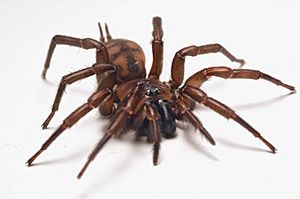Hexathele facts for kids
Quick facts for kids Hexathele |
|
|---|---|
 |
|
| Female Hexathele hochstetteri | |
| Scientific classification |
|
| Kingdom: | Animalia |
| Phylum: | Arthropoda |
| Subphylum: | Chelicerata |
| Class: | Arachnida |
| Order: | Araneae |
| Infraorder: | Mygalomorphae |
| Family: | Hexathelidae |
| Genus: | Hexathele Ausserer, 1871 |
| Type species | |
| H. hochstetteri Ausserer, 1871
|
|
| Species | |
|
20, see text |
|
Hexathele is a group of funnel-web spiders that live only in New Zealand. These spiders were first described by Anton Ausserer in 1871. However, many more Hexathele species were later found and described by Raymond Robert Forster. At first, these spiders were thought to be related to curtain web spiders. But in 1980, scientists moved them to their own family, the Hexathelidae.
What Hexathele Spiders Look Like
Most Hexathele spiders are quite large. For example, a female Hexathele waita, which is one of the biggest species, can have a main body part (called a carapace) about 13 mm (0.5 in) long. Her back part (called an abdomen) can be about 15 mm (0.6 in) long. The longest leg, which is usually the fourth one, can reach about 38 mm (1.5 in) in total length.
These spiders are usually brown or black. Many Hexathele species have a special V-shaped pattern, like a chevron, on the top of their abdomen. This pattern helps scientists tell different species apart.
The carapace, which is the hard shell covering the front part of the spider's body, has a straight dip in the middle. This dip is called a fovea. All of their eyes are grouped closely together.
Male Hexathele spiders have special feelers called palps near their mouth. These palps do not have certain bumps (called tibial apophyses). However, the male's first pair of legs has two sharp points (spines) on a part called the tibia. These spiders also have six spinnerets, which are special organs that spin silk. The back pair of spinnerets is made of three parts and is quite long.
How Hexathele Spiders Are Classified
The group Hexathele was officially named by Anton Ausserer in 1871. He named it after the species Hexathele hochstetteri.
At first, spiders like Hexathele (which are called mygalomorph spiders) were grouped very broadly. In 1892, a scientist named Eugène Simon placed Hexathele into a larger group. Later, this group became a family called Dipluridae. Raymond R. Forster, who described many new Hexathele species, used this classification.
However, in 1980, another scientist named Robert J. Raven decided that the Hexathele group was different enough to be its own family. So, he separated them into the family Hexathelidae.
Species
As of May 2019, there are twenty known species of Hexathele spiders. All of them are found only in New Zealand:
- Hexathele cantuaria Forster, 1968 – New Zealand
- Hexathele cavernicola Forster, 1968 – New Zealand
- Hexathele exemplar Parrott, 1960 – New Zealand
- Hexathele hochstetteri Ausserer, 1871 (type) – New Zealand
- Hexathele huka Forster, 1968 – New Zealand
- Hexathele huttoni Hogg, 1908 – New Zealand
- Hexathele kohua Forster, 1968 – New Zealand
- Hexathele maitaia Forster, 1968 – New Zealand
- Hexathele nigra Forster, 1968 – New Zealand
- Hexathele otira Forster, 1968 – New Zealand
- Hexathele para Forster, 1968 – New Zealand
- Hexathele petriei Goyen, 1887 – New Zealand
- Hexathele pukea Forster, 1968 – New Zealand
- Hexathele putuna Forster, 1968 – New Zealand
- Hexathele ramsayi Forster, 1968 – New Zealand
- Hexathele rupicola Forster, 1968 – New Zealand
- Hexathele taumara Forster, 1968 – New Zealand
- Hexathele waipa Forster, 1968 – New Zealand
- Hexathele waita Forster, 1968 – New Zealand
- Hexathele wiltoni Forster, 1968 – New Zealand
See also
 In Spanish: Hexathele para niños
In Spanish: Hexathele para niños

